
The Trollenberg Terror is a 1958 British science fiction horror film produced by Robert S. Baker and Monty Berman and directed by Quentin Lawrence. The film stars Forrest Tucker, Laurence Payne, Janet Munro and Jennifer Jayne. The special effects are by Les Bowie. The story is based on a 1956 British ITV "Saturday Serial" television programme written by George F. Kerr, Jack Cross and Giles Cooper under the collective pseudonym of "Peter Key". The film was released as The Crawling Eye in the United States on 7 July 1958 by Distributors Corporation of America and as The Trollenberg Terror in the United Kingdom in October 1958 by Eros Films. It played on a double bill with the British science fiction film The Strange World of Planet X, retitled Cosmic Monsters for American audiences.
Sidney Gilliat was an English film director, producer and writer.

The Great St. Trinian's Train Robbery is a British comedy film, directed by Frank Launder and Sidney Gilliat, written by Sidney and Leslie Gilliat, and released on 4 April 1966. It is the last of the original series of films based on the St Trinian's School set of images and comics, and the only one to be produced in colour. The film stars a selection of actors from previous films in the series, including George Cole, Richard Wattis, Eric Barker, Michael Ripper, and Raymond Huntley, alongside Frankie Howerd, Reg Varney, Dora Bryan, and the voice of Stratford Johns.
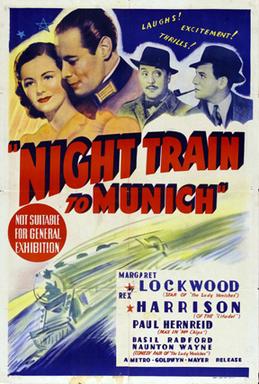
Night Train to Munich is a 1940 British thriller film directed by Carol Reed and starring Margaret Lockwood and Rex Harrison. Written by Sidney Gilliat and Frank Launder, based on the 1939 short story Report on a Fugitive by Gordon Wellesley, the film is about an inventor and his daughter who are kidnapped by the Gestapo after the Nazis march into Prague in the prelude to the Second World War. A British secret service agent follows them, disguised as a senior German army officer pretending to woo the daughter over to the Nazi cause.
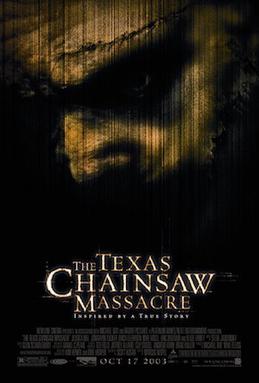
The Texas Chainsaw Massacre is a 2003 American slasher film directed by Marcus Nispel, written by Scott Kosar, and starring Jessica Biel, Jonathan Tucker, Erica Leerhsen, Mike Vogel, Eric Balfour, and R. Lee Ermey. Its plot follows a group of young adults traveling through rural Texas who encounter Leatherface and his murderous family. It is a remake of Tobe Hooper's 1974 film of the same name, and the fifth installment in The Texas Chainsaw Massacre franchise. Several crew members of the original film were involved with the project: Hooper and writer Kim Henkel served as co-producers, Daniel Pearl returned as cinematographer, and John Larroquette reprised his voice narration for the opening intertitles.

The Texas Chainsaw Massacre: The Beginning is a 2006 American slasher film and a prequel to the 2003 film. The sixth installment in The Texas Chainsaw Massacre franchise, it was written by Sheldon Turner from a story by Turner and David J. Schow, directed by Jonathan Liebesman and co-produced by Kim Henkel and Tobe Hooper. The film's story takes place four years before its predecessor. It stars Jordana Brewster, Diora Baird, Taylor Handley, Matt Bomer and R. Lee Ermey.

Jamaica Inn is a 1939 British adventure thriller film directed by Alfred Hitchcock and adapted from Daphne du Maurier's 1936 novel of the same name. It is the first of three of du Maurier's works that Hitchcock adapted. It stars Charles Laughton and Maureen O'Hara in her first major screen role. It is the last film Hitchcock made in the United Kingdom before he moved to the United States.
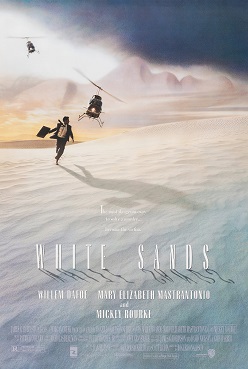
White Sands is a 1992 American crime thriller film directed by Roger Donaldson and starring Willem Dafoe, Mary Elizabeth Mastrantonio, Samuel L. Jackson, and Mickey Rourke. Written by Daniel Pyne for Warner Bros., the film is about a U.S. southwestern small-town sheriff who finds a body in the desert with a suitcase and $500,000. He impersonates the man and stumbles into an FBI investigation.

Watchers is a 1988 science fiction horror film directed by Jon Hess and starring Corey Haim, Michael Ironside, Barbara Williams and Lala Sloatman. It is loosely based on the 1987 novel Watchers by Dean R. Koontz.

The Lady Vanishes is a 1938 British mystery thriller film directed by Alfred Hitchcock, starring Margaret Lockwood and Michael Redgrave. Written by Sidney Gilliat and Frank Launder, based on the 1936 novel The Wheel Spins by Ethel Lina White, the film is about an English tourist travelling by train in continental Europe who discovers that her elderly travelling companion seems to have disappeared from the train. After her fellow passengers deny ever having seen the elderly lady, the young woman is helped by a young musicologist, the two proceeding to search the train for clues to the old lady's disappearance.

The Years Between (1946) is a British film directed by Compton Bennett and starring Michael Redgrave, Valerie Hobson and Flora Robson in an adaptation of the 1945 play The Years Between by Daphne du Maurier. It was shot at the Riverside Studios.

The Pooch is a 1932 Our Gang short comedy film directed by Robert F. McGowan. It was the 115th Our Gang short to be released.

Alice in Wonderland is a 1949 French film based on Lewis Carroll's 1865 fantasy novel Alice's Adventures in Wonderland. Directed by Dallas Bower, the film stars Carol Marsh as Alice, Stephen Murray as Lewis Carroll, and Raymond Bussières as The Tailor. Most of the Wonderland characters are portrayed by stop-motion animated puppets created by Lou Bunin.
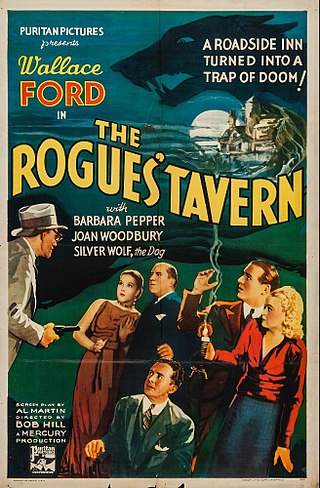
The Rogues' Tavern is a 1936 American murder mystery film directed by Robert F. Hill and starring Wallace Ford, Barbara Pepper, and Joan Woodbury. The film was produced by Mercury Pictures, and released by Puritan Picture on June 4, 1936.

The Girl in the News is a 1940 British thriller film directed by Carol Reed and starring Margaret Lockwood, Barry K. Barnes and Emlyn Williams. It was based on the eponymous novel by Roy Vickers, released the same year.
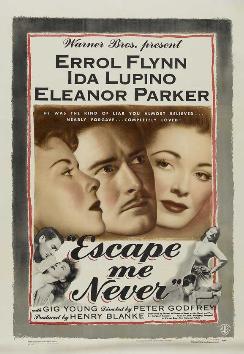
Escape Me Never is a 1947 American melodrama film directed by Peter Godfrey, and starring Errol Flynn, Ida Lupino, Eleanor Parker, and Gig Young.

Big Top Scooby-Doo! is a 2012 direct-to-DVD animated comedy mystery film, the eighteenth entry in the direct-to-video series of Scooby-Doo films. The DVD was released on October 9, 2012, by Warner Home Video, and made its TV premiere on September 8, 2012, on Cartoon Network in the United States.
William Jackson is a fictional character in Wentworth Prison. Will is portrayed by Robbie Magasiva. Will is notable for his friendships with Matthew Fletcher and Bea Smith. Will has also been involved in a one-sided rivalry with Joan Ferguson.
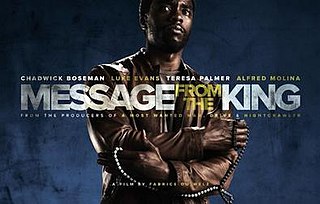
Message from the King is a 2016 revenge-action-thriller film directed by Fabrice Du Welz, and written by Stephen Cornwell and Oliver Butcher. The film is produced by Cornwell, David Lancaster and Simon Cornwell and stars Chadwick Boseman, Luke Evans, Teresa Palmer, and Alfred Molina. The film's plot revolves around Jacob King (Boseman), a man from Cape Town, South Africa who travels to Los Angeles in order to find his younger sister and after finding out she is dead, he works to avenge her death.
















